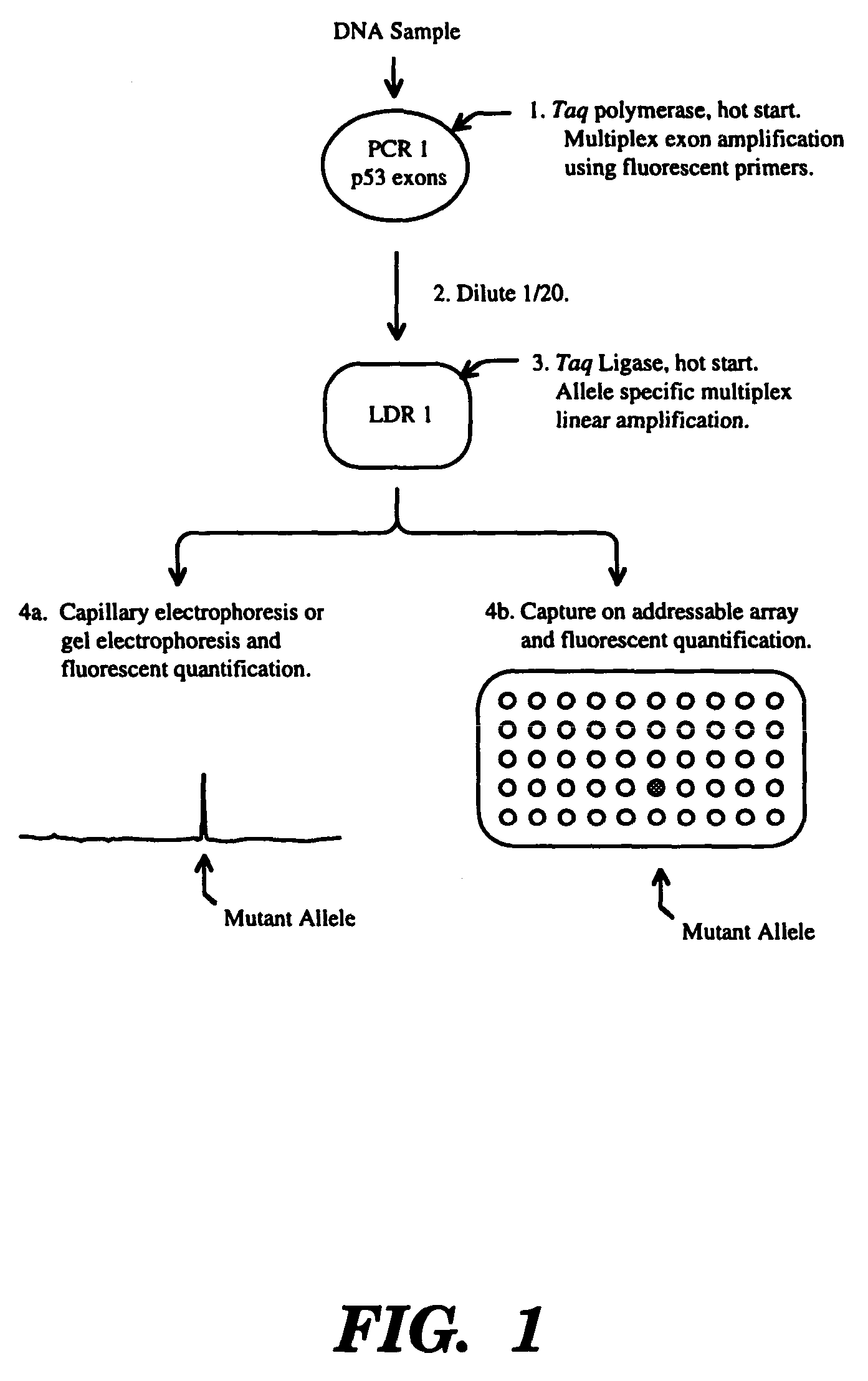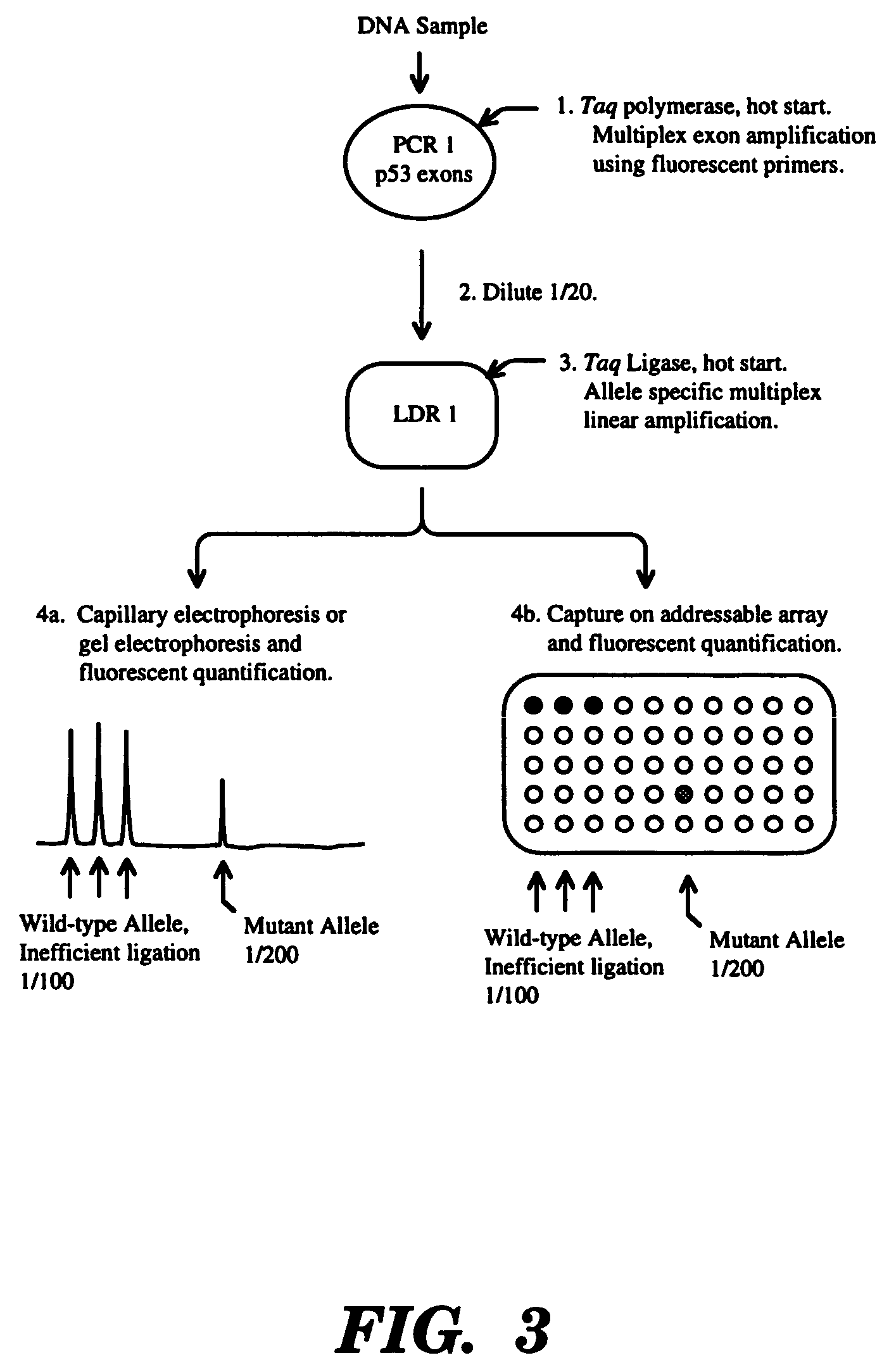High fidelity detection of nucleic acid differences by ligase detection reaction
a nucleic acid and ligase technology, applied in the field of high fidelity detection of nucleic acid sequence differences, to achieve the effect of accurate quantification, greater fidelity ratio of thermostable mutant ligase, and altering ligation ra
- Summary
- Abstract
- Description
- Claims
- Application Information
AI Technical Summary
Benefits of technology
Problems solved by technology
Method used
Image
Examples
example 1
Construction of Thermus thermophilus DNA Ligase Mutants at Amino Acid Residue 294 Using Site-Specific Mutagenesis
[0161]Thermus thermophilus (“Tth”) DNA ligase mutants were created using a two-step PCR method (Horton et al., “Engineering Hybrid Genes Without the Use of Restriction Enzymes: Gene Splicing By Overlap Extension,”Gene, 77:61–68 (1989), which is hereby incorporated by reference). Plasmid pDZ15 (linearized by HindIII) was used as a template in the first round of PCR reactions. In the upper panel of FIG. 10, plasmid pDZ15 which contains the cloned Tth DNA ligase gene (SEQ. ID. NO: 97) (Barany, F., et al., “Cloning, Overexpression, and Nucleotide Sequence of a Thermostable DNA Ligase Gene,”Gene 109:1–11 (1991), which is hereby incorporated by reference), is shown schematically as if opened at a PstI site with genes drawn approximately to scale. In pDZ15, the Tth ligase gene and direction is represented by the strongly hatched arrow; the vector ApR (bla) gene represented by th...
example 2
Construction of Tth DNA Ligase Mutants K294R and K294P
[0164]The mutant ligases of FIG. 11 were prepared using the oligonucleotides of FIG. 12A–B as described infra. Four oligonucleotide primers for PCR reactions were designed for creating multiple site-specific mutations at K294 site. Their sequences are as follows: Primer a (JL505) (SEQ. ID. No. 78): 5′CAG AAC CTC CTC ACC ATC 3′; Primer b (JL507R) (SEQ. ID. No. 79): 5′CTC GTC CAG (G,C) (T, G, C, A) G CAC CAC CAC CCC GTC 3′; Primer c (JL506) (SEQ. ID. No. 88): 5′ TGG TGG TGC (A, C, G, T) (C, G) C TGG ACG AGC TTG CCC T 3′; and Primer d (JL508R) (SEQ. ID. No. 96): 5′ CTC TAT GTA GCT CTC GTT GTG 3′. Primers b and c are overlapping primers containing degenerate codons at mutation site. These primers were synthesized using reagents and a 394 automated DNA synthesizer from Applied Biosystems Division of Perkin-Elmer Corporation, Foster City, Calif. After synthesis, primers were deprotected in 30% ammonium hydroxide at 55° C. for 12 hours,...
example 3
Expression of Mutant Tth DNA Ligases in E. coli
[0166]Plasmids containing mutant Tth DNA ligase gene under control of aphoA promoter were introduced into E. coli strain, AK53 via transformation. Mutant Tth DNA ligase proteins were overexpressed at 30° C. for 15 hours in 6 ml MOPS medium (Neidhardt, et al., J. Bacteriol., 119:736–47 (1974), which is hereby incorporated by reference) containing 0.2 mM K2HPO4 and 75 μg / ml ampicillin (F. Barany, et al., Gene 109:1–11 (1991), which is hereby incorporated by reference). Cells were harvested by centrifugation, resuspended in 400 μl TE, (10 mM Tris, pH 8.5, 1 mM EDTA) sonicated for 3×10 seconds with a microprobe on a Sonifier 350 cell disruptor from VWR, and centrifuged for 10 min. at 4° C. The supernatant was adjusted to 20 mM Tris-HCl, pH 8.5, 50 mM KCl, 10 mM MgCl2, and 0.5 mM EDTA, 1 mM DTT, and 2 mM 2-mercaptoethanol. After incubation at 64° C. for 25 min, the cloudy suspension was clarified by centrifugation at 4° C. for 15 min. Over ...
PUM
| Property | Measurement | Unit |
|---|---|---|
| pH | aaaaa | aaaaa |
| pH | aaaaa | aaaaa |
| temperature | aaaaa | aaaaa |
Abstract
Description
Claims
Application Information
 Login to View More
Login to View More - R&D
- Intellectual Property
- Life Sciences
- Materials
- Tech Scout
- Unparalleled Data Quality
- Higher Quality Content
- 60% Fewer Hallucinations
Browse by: Latest US Patents, China's latest patents, Technical Efficacy Thesaurus, Application Domain, Technology Topic, Popular Technical Reports.
© 2025 PatSnap. All rights reserved.Legal|Privacy policy|Modern Slavery Act Transparency Statement|Sitemap|About US| Contact US: help@patsnap.com



